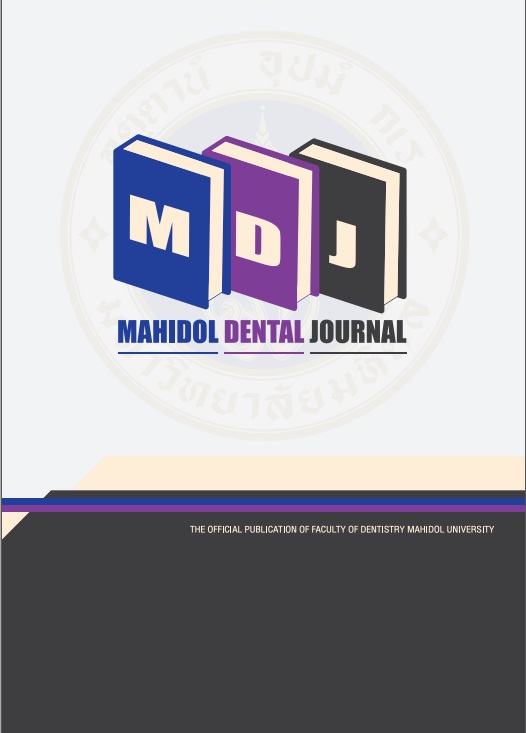Cytotoxic effect of Kaempferia parviflora extract on normal oral keratinocytes and a human squamous carcinoma cell line
Main Article Content
Abstract
Objective: The purpose of this study was to investigate the cytotoxic effect of K. parviflora extract on normal oral keratinocytes (NOK) and a human squamous carcinoma cell line (HSC-4).
Materials and Methods: The cytotoxic effect of ethanolic extract of K. parviflora root (0.46, 0.93, 1.87, 3.75, 7.5, 15, and 30 mg/ml) on normal oral keratinocytes and a human squamous carcinoma cell line was evaluated using an MTT assay per ISO 10993-5/2009.
Results: The results revealed that after exposure to 0.46, 0.93, 1.87, 3.75, and 7.5 mg/ml K. parviflora extract NOK cell viability was 113%, 99%, 96%, 91%, and 75%, respectively, whereas 15 mg/ml and 30 mg/ml K. parviflora root treatment decreased cell viability to ~15–31%. In HSC-4 cells, no cytotoxicity was demonstrated at concentrations ≤ 30 mg/ml.
Conclusion: K. parviflora extract at concentrations ≤ 7.5 mg/ml was not cytotoxic to NOKs, and concentrations from 0.46–30 mg/ml were not cytotoxic to HSC-4 cells. This study provides additional basic knowledge concerning the biological response of NOK and HSC-4 cells to K. parviflora extract.
Article Details

This work is licensed under a Creative Commons Attribution-NonCommercial-NoDerivatives 4.0 International License.
References
Motaleb M, Hossain M, Alam M, Mamun M, Sultana M. Commonly used Medicinal Herbs and Shrubs by Traditional Herbal Practitioners: Glimpses from Thanchi upazila of Bandarban 2013; pp i-xii: 1-294.
Sirirugsa P. The genus Kaempferia (Zingiberaceae) in Thailand. Nord J Bot 1989; 9: 257-60.
Mekjaruskul C, Sripanidkulchai B. Pharmacokinetic interaction between Kaempferia parviflora extract and sildenafil in rats. J Nat Med 2015; 69 :224-31.
Azuma T, Tanaka Y, Kikuzaki H. Phenolic glycosides from Kaempferia parviflora. Phytochem 2008; 69: 2743-8.
Wattanapitayakul SK, Suwatronnakorn M, Chularojmontri L, Herunsalee A, Niumsakul S, Charuchongkolwongse S, et al. Kaempferia parviflora ethanolic extract promoted nitric oxide production in human umbilical vein endothelial cells. J Ethnopharmacol 2007; 110: 559-62.
Sookkongwaree K, Geitmann M, Roengsumran S, Petsom A, Danielson UH. Inhibition of viral proteases by Zingiberaceae extracts and flavones isolated from Kaempferia parviflora. Pharmazie 2006; 61: 717-21.
Wongsinkongman P, Mongkolchaipak N, Chansuvanich N, Techadumrongsin Y, Boonruad T. Quality evaluation of crude drugs and volatile oil of Krachai-dam rhizomes. Bull Dept Med Sci 2003; 45: 1-16.
Chaipech S, Morikawa T, Ninomiya K, Yoshikawa M, Pongpiriyadacha Y, Hayakawa T, et al. Structures of two new phenolic glycosides, kaempferiaosides A and B, and hepatoprotective constituents from the rhizomes of Kaempferia parviflora. Chem Pharm Bull 2012; 60: 62-9.
Mekjaruskul C, Jay M, Sripanidkulchai B. Pharmacokinetics, bioavailability, tissue distribution, excretion, and metabolite identification of methoxyflavones in Kaempferia parviflora extract in rats. Drug Metab Dispos 2012; 40: 2342-53.
Potikanond S, Sookkhee S, Na Takuathung M, Mungkornasawakul P, Wikan N, Smith DR, et al. Kaempferia parviflora Extract Exhibits Anti-cancer Activity against HeLa Cervical Cancer Cells. Front Pharmacol 2017; 8: 630.
Piboonniyom S, Duensing S, Swilling NW, Hasskarl J, Hinds PW, Münger K. Abrogation of the retinoblastoma tumor suppressor checkpoint during keratinocyte immortalization is not sufficient for induction of centrosome-mediated genomic instability. Cancer Res 2003; 63: 476-83.
International Organization for Standardization, Biological evaluation of medical devices-Part
: Tests for in vitro cytotoxicity, third ed., Switzerland, 2009.
Park JE, Woo SW, Kim MB, Kim C, Hwang JK. Standardized Kaempferia parviflora Extract Inhibits Intrinsic Aging Process in Human Dermal Fibroblasts and Hairless Mice by Inhibiting Cellular Senescence and Mitochondrial Dysfunction. Evid-Based Compl Alt 2017; 6861085: 14.
Srivastava N, Ranjana, Singh S, Gupta AC, Shanker K, Bawankule DU, et al. Aromatic ginger (Kaempferia galanga L.) extracts with ameliorative and protective potential as a functional food, beyond its flavor and nutritional benefits. Toxicology Rep 2019; 6: 521-8.
Yenjai C, Prasanphen K, Daodee S, Wongpanich V, Kittakoop P. Bioactive flavonoids from Kaempferia parviflora. Fitoterapia 2004; 75: 89-92.
Kumar S, Pandey AK. Chemistry and Biological Activities of Flavonoids: An Overview. Scientific World J 2013; 162750: 1-16.
Banjerdpongchai R, Suwannachot K, Rattanapanone V, Sripanidkulchai B. Ethanolic rhizome extract from Kaempferia parviflora Wall. ex. Baker induces apoptosis in HL-60 cells. Asian Pac J Cancer Prev 2008; 9: 595-600.
Bourgaud, F., Gravot, A., Milesi, S. and Gontier, E. Production of Plant Secondary Metabolites: A Historical Perspective. Plant Sci 2001; 161: 839-51.
Ab Rahman, Z. , Abd Shukor, S. , Abbas, H. , A. L. Machap, C. , Suhaimi Bin Alias, M. , Mirad, R. , Sofiyanand, S. and Nazreena Othman, A. Optimization of Extraction Conditions for Total Phenolics and Total Flavonoids from Kaempferia parviflora Rhizomes. Adv Biosci Biotechnol 2018; 9: 205-14.
Tangjitjaroenkun, J., Yahayo, W., Supabphol, S., & Supabphol, R. Selective Cytotoxicity of Kaempferia parviflora Extracts in Human Cell Lines. Asian Pac J Cancer Prev 2021; 22: 73-9.
Gawas, N.P., Navarange, S.S., Chovatiya, G.L., Chaturvedi, P., & Waghmare, S.K. Establishment and characterization of novel human oral squamous cell carcinoma cell lines from advanced stage tumors of buccal mucosa. Oncol Rep 2019; 41: 2289-98.
ISO 10993-12:2012 – Biological evaluation of medical devices – Part 12: Sample preparation and reference materials.
ISO 10993-5:2009 - Biological evaluation of medical devices - Part 5: Tests for in vitro cytotoxicity (ISO 10993-5:2009)


